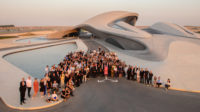Martin Filler Responds to Zaha Hadid's Lawsuit Against the New York Review of Books
Architects & Firms

A lawsuit brought by Zaha Hadid against The New York Review of Books and its architecture critic, Martin Filler, has prompted Filler to correct the record. In a book review published in June, Filler accused Hadid of being indifferent to the deaths of 1,000 workers during construction of her Al Wakrah Stadium in Qatar, a venue for the 2020 FIFA World Cup, based on comments the architect had made to The Guardian newspaper in February 2014. In a letter posted on the NYRB website on Monday – four days after Hadid filed suit – Filler conceded: "I wrote that an 'estimated one thousand laborers...have perished while constructing her project thus far.' However, work did not begin on the site for the Al Wakrah stadium, until two months after Ms. Hadid made those comments; and construction is not scheduled to begin until 2015. There have been no worker deaths on the Al Wakrah project and Ms. Hadid’s comments about Qatar that l quoted in the review had nothing to do with the Al Wakrah site or any of her projects. I regret the error."
Soon after receiving Filler’s letter, Hadid’s New York lawyer, Oren Warshavsky, said, “Ms. Hadid together together with counsel are reviewing it now and will respond after further careful consideration.” Hadid’s lawsuit was filed in New York State Supreme Court in Manhattan on Thursday. As news of the lawsuit spread through architecture circles last week, it looked as though Goliath was aiming a slingshot at David. Hadid may be the world’s most successful architect, with 40 active projects, some of them with budgets of over $1 billion.
The lawsuit prompted architecture critic Paul Goldberger to tweet last week: “Zaha proves Goldberger's Law: the greater the success the thinner the skin." Yet filing the lawsuit guaranteed that people would be discussing the very article she said, in her complaint, had caused her "severe emotional and physical distress." Most of Filler’s piece remains behind the NYRB paywall, but in the wake of the lawsuit, excerpts were published in many publications.
Hadid may well have known that would happen. According to Warshavsky, "Prior to filing the lawsuit, Ms. Hadid carefully considered the issues at stake to her professional career and reputation." In her complaint, Hadid stated that Filler used the article – a review of Rowan Moore’s book Why We Build: Power and Desire in Architecture – as an excuse to attack the London-based architect. The complaint noted "almost two-thirds of the paragraphs in [Filler’s] article mention Hadid."
The article also takes on other targets, including Santiago Calatrava, the late New York Times critic Herbert Muschamp, and occasionally Moore himself. But Filler saves his harshest criticism for the governments of the United Arab Emirates, whose treatment of workers he abhors.



